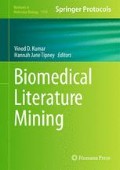Abstract
Knowledge discovery in biomedicine is a time-consuming process starting from the basic research, through preclinical testing, towards possible clinical applications. Crossing of conceptual boundaries is often needed for groundbreaking biomedical research that generates highly inventive discoveries. We demonstrate the ability of a creative literature mining method to advance valuable new discoveries based on rare ideas from existing literature. When emerging ideas from scientific literature are put together as fragments of knowledge in a systematic way, they may lead to original, sometimes surprising, research findings. If enough scientific evidence is already published for the association of such findings, they can be considered as scientific hypotheses. In this chapter, we describe a method for the computer-aided generation of such hypotheses based on the existing scientific literature. Our literature-based discovery of NF-kappaB with its possible connections to autism was recently approved by scientific community, which confirms the ability of our literature mining methodology to accelerate future discoveries based on rare ideas from existing literature.
Access this chapter
Tax calculation will be finalised at checkout
Purchases are for personal use only
References
US National Library of Medicine. Fact sheet. Medline, PubMed, and PMC (PubMed Central): how are they different? http://www.nlm.nih.gov/pubs/factsheets/dif_med_pub.html. Accessed 5 Aug 2013
Koestler A (1964) The act of creation. Macmillan, New York, p 751
Feldman R, Sanger J (2007) The text mining handbook: advanced approaches in analyzing un-structured data. Cambridge University Press, Cambridge, p 410
Swanson DR (1986) Fish oil, Raynaud’s syndrome, and undiscovered public knowledge. Perspect Biol Med 30(1):7–18
Weeber M, Vos R, Klein H, de Jong-van den Berg LTW (2001) Using concepts in literature-based discovery: simulating Swanson’s Raynaud–fish oil and migraine–magnesium discoveries. J Am Soc Inf Sci Tech 52(7):548–557
Hristovski D, Rindflesch T, Peterlin B (2013) Using literature-based discovery to identify novel therapeutic approaches. Cardiovasc Hematol Agents Med Chem 11(1):14–24
Frijters R, van Vugt M, Smeets R, van Schaik R, de Vlieg J, Alkema W (2010) Literature mining for the discovery of hidden connections between drugs, genes and diseases. PLoS Comput Biol 6(9):e1000943
Petrič I, Urbančič T, Cestnik B (2007) Discovering hidden knowledge from biomedical literature. Informatica 31(1):15–20
Petrič I, Urbančič T, Cestnik B, Macedoni-Lukšič M (2009) Literature mining method RaJoLink for uncovering relations between biomedical concepts. J Biomed Inform 42(2):219–227
Urbančič T, Petrič I, Cestnik B, Macedoni-Lukšič M (2007) Literature mining: towards better understanding of autism. In: Bellazzi R, Abu-Hanna A, Hunter J (eds) Proceedings of the 11th conference on artificial intelligence in medicine in Europe, AIME 2007, July 7–11, Amsterdam, The Netherlands, pp 217–226
Naik US, Gangadharan C, Abbagani K, Nagalla B, Dasari N, Manna SK (2011) A study of nuclear transcription factor-kappa B in childhood autism. PLoS One 6(5):e19488
Nelson SJ, Johnston D, Humphreys BL (2001) Relationships in medical subject headings. In: Bean CA, Green R (eds) Relationships in the organization of knowledge. Kluwer Academic Publishers, New York, pp 171–184
Swanson DR (1990) Medical literature as a potential source of new knowledge. Bull Med Libr Assoc 78(1):29–37
Petrič I, Cestnik B, Lavrač N, Urbančič T (2012) Outlier detection in cross-context link discovery for creative literature mining. Comput J 55(1):47–61
Sayers E, Wheeler D (2004) Building customized data pipelines using the entrez programming utilities (eUtils) In: U.S. National Library of Medicine. NCBI short courses
Juršič M, Mozetič I, Lavrač N (2007) Learning ripple down rules for efficient lemmatization. In: Bohanec M et al (eds) Proc. 10th intl. multiconference information society IS 2007, vol A. pp 206–209
Sebastiani F (2002) Machine learning in automated text categorization. ACM Comput Surv 34(1):1–47
Grobelnik M, Mladenić D (2004) Extracting human expertise from existing ontologies. In: EU-IST Project IST-2003-506826 SEKT
Fortuna B, Grobelnik M, Mladenić D (2006) Semi-automatic data-driven ontology construction system. In: Bohanec M et al (eds) Proc. 9th intl. multiconference information society IS 2006, vol A. pp 223–226
Acknowledgement
This work was performed within the Creative Core project (AHA-MOMENT), partially supported by the Ministry of Education, Science and Sport, Republic of Slovenia, and European Regional Development Fund.
Author information
Authors and Affiliations
Corresponding author
Editor information
Editors and Affiliations
Rights and permissions
Copyright information
© 2014 Springer Science+Business Media New York
About this protocol
Cite this protocol
Petrič, I., Cestnik, B. (2014). Predicting Future Discoveries from Current Scientific Literature. In: Kumar, V., Tipney, H. (eds) Biomedical Literature Mining. Methods in Molecular Biology, vol 1159. Humana Press, New York, NY. https://doi.org/10.1007/978-1-4939-0709-0_10
Download citation
DOI: https://doi.org/10.1007/978-1-4939-0709-0_10
Published:
Publisher Name: Humana Press, New York, NY
Print ISBN: 978-1-4939-0708-3
Online ISBN: 978-1-4939-0709-0
eBook Packages: Springer Protocols

